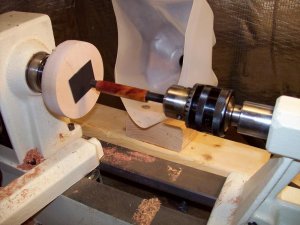1. I've decided I don't like the pen mill. It's too rough, and with the more sensitive woods it tends to chip and scar the edges of my blanks. I also don't care to use it on acrylics.
2. I would prefer to use sanding. I have sanded the ends of some blanks by hand, but they come out uneven. I don't have the money for an upright disc sander right now.
3. I've seen suggestions for using the lathe with a sanding disc, and I know there is a very popular solution out there for doing this that is inexpensive. However, I also currently use my lathe for blank preparation, turning and finishing. I'd prefer not to add one more function to the lathe in order to limit the number of tool changes, etc. I'm doing on it at any given time.
So... Are there any alternative methods for trimming blanks that you might recommend?
One idea that I had (and wonder if anyone has tried) is using a Dremel tool with a sanding disc attachment. It seems that this would be small and nimble enough to allow for sufficient control and ensure you don't over-sand. Granded, there is an issue with evenness. Any thoughts on this?
2. I would prefer to use sanding. I have sanded the ends of some blanks by hand, but they come out uneven. I don't have the money for an upright disc sander right now.
3. I've seen suggestions for using the lathe with a sanding disc, and I know there is a very popular solution out there for doing this that is inexpensive. However, I also currently use my lathe for blank preparation, turning and finishing. I'd prefer not to add one more function to the lathe in order to limit the number of tool changes, etc. I'm doing on it at any given time.
So... Are there any alternative methods for trimming blanks that you might recommend?
One idea that I had (and wonder if anyone has tried) is using a Dremel tool with a sanding disc attachment. It seems that this would be small and nimble enough to allow for sufficient control and ensure you don't over-sand. Granded, there is an issue with evenness. Any thoughts on this?

